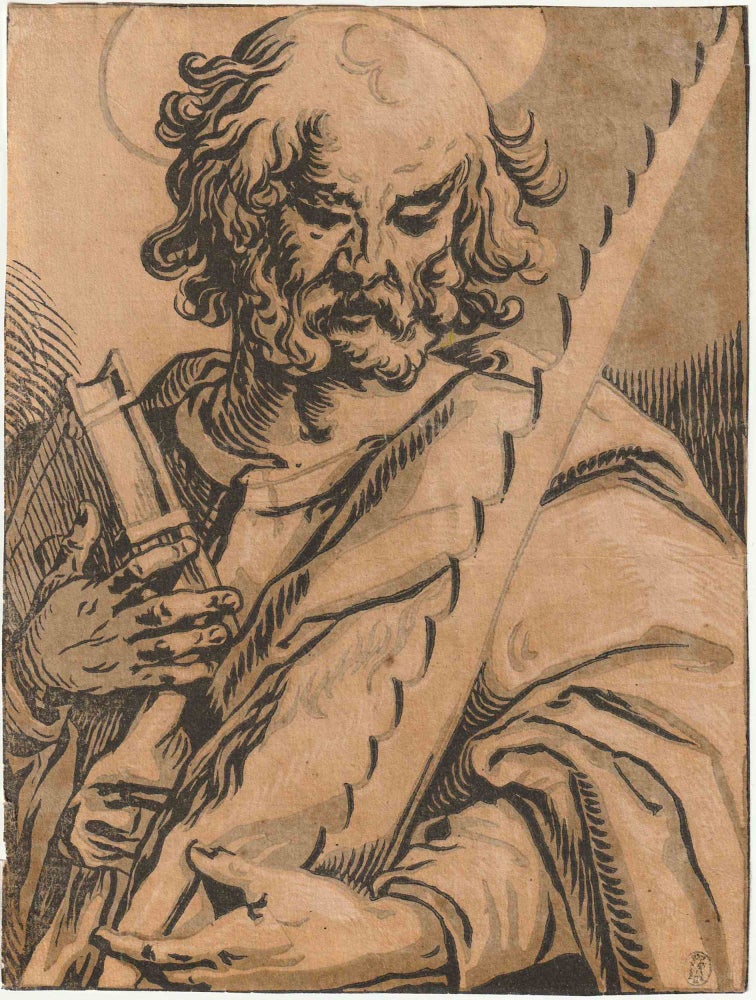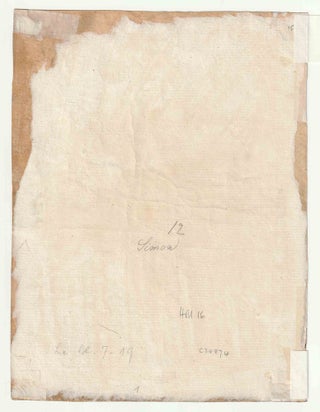Saint Simon, from Christ and the Apostles
Paris: Melchior Tavernier, c 1620. Chiaroscuro woodcut on cream laid paper, printed from three blocks in black, olive-green, and yellow ochre, 8 3/16 x 6 1/4 inches (207 x 157 mm), thread margins. Some scattered light discoloration throughout, lightly backed with laid paper, however the sheet retains translucence when viewed through raking light. Trimmed at or near the margin. Archivally sound small repaired corner tear, upper right, with a very minor (1/4 inch) vertical edge split in the center top margin, above the figure's head. All condition issues are consistent with age, and present an exceptionally good example of this truly remarkable work. With the collector's stamp of Friedrich August II, King of Saxony, last King of Poland (1797-1854), Dresden, on the right corner, recto (Lugt 971). This work likely appeared in a well-known posthumous sale of Friedrich August II's private collection, which was handled by C.G. Boerner, and took place in Leipzig, on May 7-9, 1928, presumably this print was presented as lot 1551.
[Stechow 16].
Ludolph Busïnck was born at Hann, Germany around 1590. By about 1620 he was actively working as a printmaker in Paris, collaborating with publisher and celebrated cartographer Melchoir Tavernier. Busïnck may have studied printmaking in the Netherlands, evidenced by the influence of Dutch printmaker Hendrick Goltzius we see in the bold woodcuts he produced in France. Busïnck was the first printmaker to create chiaroscuro woodcuts in France, a technique originated by German artist Hans Burgkmair (1473–1531) in 1509. This technique adored by printmakers because of the depth of light and shadow it achieved, which evoked the tonality of ink wash drawings. Most of Busïnck's woodcuts were based on paintings by George Lallemande. His first woodcut, however, was after Abraham Bloemaert. Busïnck is not known to have produced any prints after 1630, the year in which he left Paris and returned to Germany to work as a customs official. He died at Münden on 15 January 1669.
Provenance: Friedrich August II, King of Saxony
Born Friedrich August Albrecht Maria Clemens Joseph Vincenz Aloys Nepomuk Johann Baptista Nikolaus Raphael Peter Xavier Franz de Paula Venatius Felix on May 18th, 1797, Friedrich August II was a political reformer who enjoyed a relatively uneventful reign. He was appointed to the throne by his childless uncle, King Anton. Friedrich August II had two childless marriages himself, and became increasingly less active in governing as he aged. Instead, he delved deeply into his interest in art and his passion for the sciences. He was an amateur botanist and collector of fossils, and he accumulated an impressive natural history collection. He traveled extensively, and was a guest of Queen Victoria in London in 1844. Friedrich August II died on August 8th, 1856 from injuries sustained in a carriage accident in Tyrol, Austria, where he was taking part in a botany expedition.
A major collector of print and drawings, his vast collection was sold in Leipzig by C.G. Boerner in three parts after his death. Two major sales in 1856 and 1900, and a third sale in 1927.
Item number: 592
Price: $15,000.00
Share:

